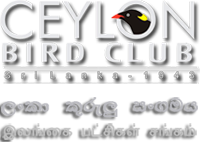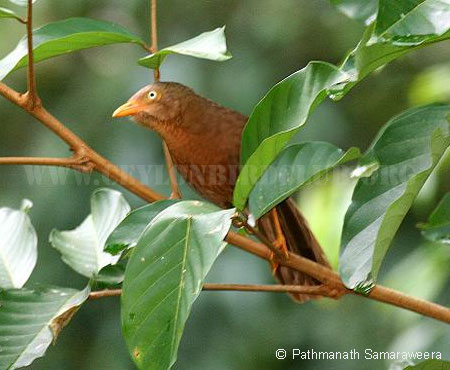


Ceylon Rufous Babbler Turdoides rufescens
(Orange-billed Babbler)
Sinhalese - Ratu Demalichcha
Tamil - Velaikkara Kuruvi

The Ceylon Rufous Babbler is an inhabitant of the wet zone forests and wet hills up to the highest elevations from almost sea level to the Horton plains. It is often also seen in adjoining home gardens and groves. Similar in size and form to the familiar Common Babbler, it is much more attractive than that species with its red-brown plumage and orange beak and legs. Within its forest habitat it is not uncommon, being a nucleus species of mixed feeding flocks. Like the Common Babbler, it moves in flocks. The flocks sometimes are very large. It occupies all levels of the forest, from canopy to the forest floor. The arrival of a flock is heralded by loud, squeaking calls. After a flock arrives making these high pitched calls, the birds continue to utter rather lower pitched squeaking calls while feeding. If any danger is sensed they resort to their high pitched loud calls again. The Dusky striped Squirrel as well as the Layard’s Squirrel often associates with these birds. Food consists of both animal and vegetable matter. The flight is weak and confined to short spells from one patch to another. The birds hop about energetically however, and while searching for food amongst foliage assume many acrobatic poses. Occasionally during the hot afternoons a troop can be seen to stay comparatively inactive, preening themselves or each other.
Records of nesting of the Ceylon Rufous Babbler are very meagre. W W A Phillips, a founder member of the Ceylon Bird Club writes in his series on the Nests and Eggs of Ceylon Birds in the CeylonJournal of Science “unlike the last species (the Common Babbler) this babbler is such an adept at concealing its nest that little is known of its nidification. Although I lived for several years in a district where it was far from uncommon, I was unable to discover a nest which undoubtedly belonged to the present species” According to Vincent W Legge, the bird breeds during March, April and May and the eggs which are deep greenish-blue in colour number two or three.
The first definitive nest was found by Ceylon Bird Club member Deepal Warakagoda in Kitulgala. He has the following comments to make in the CBCN of January and February 2002. “In the village area adjoining the forest a flock of Rufous Babblers were often seen feeding. One of them was seen carrying nesting material. It flew onto a Rambutan tree in an adjoining bare land and crept into thick foliage. I found a half built nest hidden in the foliage about eight feet from the ground. The bird came regularly with nesting material. Sometimes another babbler followed the first, not coming to this tree, remaining on one nearby. It appeared that the nesting birds had partly separated from the main flock. The flock appeared to take no notice of the nest building of the two birds though in the vicinity. It seems that the above behaviour is different from that of the Common Babbler, where other birds in the flock help a breeding pair to build a nest. However this needs to be further studied before a conclusion can be reached.”
In February 2002 he found the nest completed and a bird sitting. In early March 2002 two Ceylon Bird Club members visiting the site unfortunately found the nest abandoned as there had been some cutting down of branches of nearby trees, although the flock of babblers was nearby.
Many years later, two young birds were seen in a flock of Rufous Babblers at the same site. Though smaller in size, they resembled the adults in plumage colour. Their eyes were dark and not white and they had prominent orange gapes. These birds were observed in mid October 2008 suggesting that there probably is a secondary breeding season in August- September or the birds nest sporadically throughout the year.